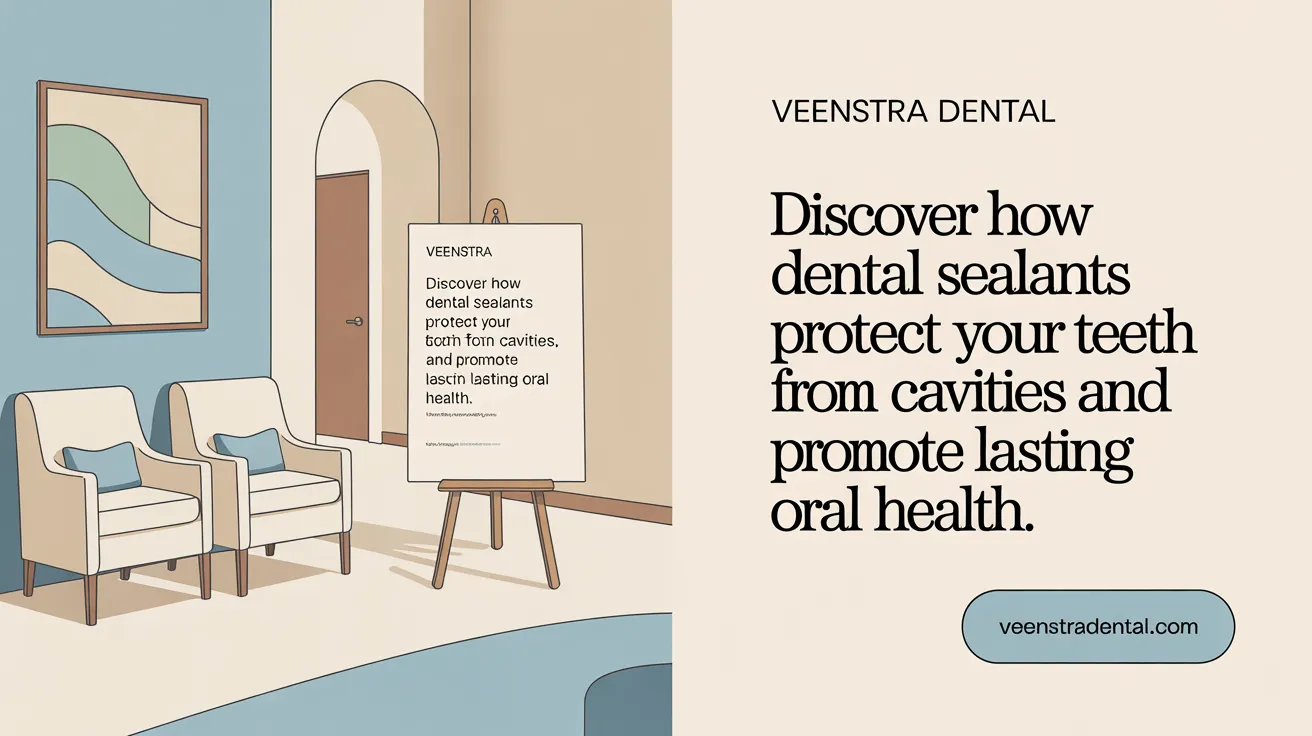Understanding the Challenge of Protecting Molars
Molars present a unique challenge in dental care due to their intricate grooves and pits that trap food, plaque, and bacteria — prime contributors to tooth decay. Dental sealants offer a proactive solution by creating a barrier that protects these hard-to-reach areas. This article delves into how sealants work, their application, benefits, and maintenance, offering insights into their crucial role in preventive dental health.
The Protective Mechanism of Dental Sealants

How do dental sealants protect molars from decay and cavities?
Dental sealants shield molars from decay by forming a thin, protective coating over the grooves, pits, and fissures of the teeth. These areas are especially prone to trapping food particles, bacteria, and plaque, which can lead to cavities.
Made of resin or glass ionomer materials, sealants create a sturdy barrier that prevents harmful bacteria and acids from reaching the enamel surface. The application involves cleaning the tooth, etching the surface with an acid to improve bonding, and then applying a light-cured sealant that adheres securely.
Some sealants also release fluoride, which helps strengthen the enamel and promote remineralization. By blocking bacterial access and food debris, sealants help keep molars healthy and cut down cavity formation. They remain effective for up to five years with regular dental check-ups, providing ongoing protection.
Overall, sealants reduce risk factors for decay by covering vulnerable surfaces, allowing children, teens, and adults to maintain healthier teeth and avoid more invasive treatments.
Step-by-Step: The Dental Sealant Application Process
 Applying dental sealants is a straightforward, quick, and painless procedure that provides vital protection for teeth at risk of decay.
Applying dental sealants is a straightforward, quick, and painless procedure that provides vital protection for teeth at risk of decay.
The process begins with thorough cleaning of the tooth surface. Dental professionals typically use pumice or chemical agents like hydrogen peroxide to remove plaque, food debris, and bacteria. Maintaining a dry environment is crucial for the sealant to bond properly. Dentists often use rubber dams, cotton rolls, or dry field pads to keep the area moisture-free.
Once the tooth is clean and dry, the next step involves etching the enamel with a 37% phosphoric acid solution. This acid treatment lasts about 15 to 20 seconds and creates tiny micropores in the tooth’s surface, enhancing sealant adhesion. After etching, the tooth is rinsed thoroughly to remove all acid residue, then dried until the surface takes on a frosty appearance, indicating optimal readiness for the sealant.
The dentist then carefully applies the liquid sealant material onto the pits, fissures, and grooves of the tooth. The application must ensure complete coverage without overfilling, to avoid trapping bacteria or food particles. Once the sealant is properly placed, a curing light—usually emitting blue light—is used to harden the coating instantly.
After curing, the dentist inspects the sealant to confirm complete coverage, smoothness, and that no bubbles are trapped inside. Adjustments may be made if necessary to ensure a proper seal.
This entire procedure typically takes about 30 minutes per session, is entirely painless, and requires no anesthesia. The result is a durable, invisible layer that acts as a barrier against bacteria, plaque, and food particles, significantly reducing the risk of cavities.
Maintaining good oral hygiene and routine dental visits are essential for the longevity of sealants. Regular check-ups allow dentists to monitor their condition and reapply or repair the sealant as needed.
In summary, the process involves cleaning, acid etching, rinsing, drying, sealant application, curing, and final inspection. This procedure continues to be a safe, effective preventive measure that significantly lowers cavity risk in vulnerable teeth.
Benefits and Preventive Role of Sealants in Dental Health

What are the benefits of using sealants on molars?
Dental sealants provide vital protection for the back teeth, especially molars, which contain deep grooves and pits that can trap food and bacteria. These thin coatings create a physical barrier that prevents decay by sealing out plaque, acids, and food particles from hard-to-clean areas. Studies show that sealants can reduce cavity risk in molars by nearly 80% within the first two years of application, with ongoing benefits lasting several years with proper maintenance.
Applying sealants is a simple, painless procedure usually completed within 30 minutes. They are most effective when placed soon after the molars erupt, typically around ages 6-12. Once sealed, the smooth surface formed by the coating makes brushing and cleaning easier, boosting overall oral hygiene. Regular dental visits ensure that sealants are intact and functioning well, and reapplication can extend their protective effect.
Sealants are also a cost-effective approach to prevent extensive dental work such as fillings or crowns. By creating a barrier against bacteria and plaque, they help maintain healthier teeth and reduce the chances of developing painful cavities.
Effectiveness and Safety of Dental Sealants

How effective and safe are dental sealants?
Dental sealants are highly effective in preventing tooth decay, particularly in the deep grooves and pits of molars and premolars. Studies show that they can reduce the risk of cavities by nearly 80% within two years and continue providing protective benefits for up to four years.
Their safety profile is well-established. Sealants are made from materials such as resin (plant or synthetic) and glass ionomers, which have been used safely since the 1970s. These materials are rigorously tested, FDA-approved, and considered non-toxic. Most importantly, the application process is quick, painless, and involves minimal risks. There are no significant side effects reported, making sealants a safe preventive measure for children and adults alike.
Beyond cavity prevention, sealants can also arrest early signs of decay by sealing off areas that are beginning to develop caries. This early intervention helps stop deterioration before more invasive treatments become necessary.
Cost-wise, sealants are an economical choice. They can significantly reduce future dental treatments, lowering overall cost and time spent in dental care. Many insurance plans, including Medicaid, cover sealants fully, making them accessible to a wide range of patients.
In summary, when applied properly by dental professionals, dental sealants offer a safe, effective, and cost-efficient strategy to keep teeth healthy and prevent decay long-term.
Longevity, Maintenance, and Best Practices for Sealants

How long do dental sealants last, and what maintenance is required?
Dental sealants generally last between 5 to 10 years. The duration depends on factors such as the quality of the material used, the skill with which they were applied, and the patient’s oral hygiene habits.
Proper maintenance is crucial for ensuring their effectiveness. This involves practicing good oral hygiene by brushing twice daily with fluoride toothpaste and flossing regularly. Avoiding hard or sticky foods can prevent damage to the sealants.
Regular dental checkups—usually every six months—are vital for monitoring the condition of the sealants. During these visits, dentists can identify signs of wear, chips, or cracks. If necessary, the sealants may be re-applied to maintain maximal protection.
Additional practices include avoiding habits like teeth grinding or clenching, which can deteriorate the sealants over time. Maintaining a balanced diet with limited sugary foods also supports overall oral health.
By keeping up with these practices, patients can maximize the lifespan of their sealants, effectively preventing cavities in the treated teeth and reducing future dental treatment costs.
Factors influencing durability
| Factor | Impact on Sealant Longevity | Explanation |
|---|---|---|
| Material quality | High-quality materials last longer | Superior resin or glass ionomer helps resist wear and tear |
| Application technique | Proper bonding increases durability | Skilled application ensures a strong bond to tooth enamel |
| Oral hygiene habits | Poor hygiene shortens lifespan | Plaque buildup can weaken or damage the sealant |
| Dietary habits | Sugary or sticky foods can cause damage | These foods can lead to bacterial growth and physical wear |
| Behavioral habits | Grinding or clenching teeth | Causes mechanical strain, cracking or chipping the sealant |
Signs sealants need replacement
- Visible cracks or chips in the coating
- Sealant falling off or signs of detachment
- New cavities forming beneath or around the sealant
- Increased plaque accumulation in the treated areas
Regular dental visits help catch these signs early, allowing timely reapplication to maintain cavity protection.
Oral hygiene and dietary recommendations
Maintaining effective oral hygiene is essential. Brush with fluoride toothpaste twice daily to strengthen enamel and prevent decay. Floss daily to remove food particles lodged between teeth.
Limit intake of sugary, sticky, or hard foods that can damage sealants or contribute to plaque buildup. Avoid chewing on ice or hard candies that might crack the coating.
Consistent use of fluoride mouth rinses and regular professional cleanings support the durability of the sealants and overall dental health.
Following these best practices helps extend the protective benefits of dental sealants, ensuring a healthier, cavity-free smile for years to come.
Sealants: A Key Ally in Protecting Your Molars
Dental sealants provide an effective, safe, and simple means to protect molars—teeth especially vulnerable to decay due to their complex surfaces. By creating a protective barrier against bacteria, plaque, and food debris, sealants reduce cavity risk significantly, particularly when applied early in life. Their painless application process, coupled with longevity spanning several years, makes them a cost-effective preventative tool that complements good oral hygiene and regular dental care. Understanding the mechanism, benefits, and maintenance of sealants empowers patients and caregivers to take an active role in preserving dental health and preventing costly and invasive procedures in the future.
References
- Dental Sealants: How They Work
- Dental Sealants
- What Are Dental Sealants? Our Pediatric Dental Experts ...
- How Dental Sealants Work: A Barrier of Protection for Your ...
- Sealants | Potomac MD | Specialist Kid's Dentist
- What Are Dental Sealants? Protecting Your Teeth from Decay
- Why Are Dental Sealants Important for Kids?
- Sealants
